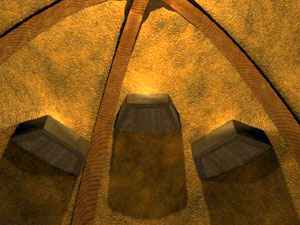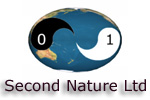Virtual Set Extensions Tutorial

This tutorial is about extending an existing set with a virtual set created with 3d computer graphics. It is the written procedure I wrote after working on such a project. It may also have relevance to any project integrating live action and cgi. See the references link at the end for another tutorial on combining cgi with a photo. Camera mapping is a related technique for creating textured 3d objects quickly from a live action photograph which allows some minor virtual camera movement. A link to a tutorial on camera mapping can also be found at the end of this tutorial.
Planning
What resolution will the project be rendered at? This has implications
for both modeling detail and the resolution required for photographic
textures. How close will the camera get to the virtual set elements?
Is it a locked off shot? If it isn’t you may be able to
use camera matching software to match the camera position and
focal length. What will the virtual set consist of – what
physical objects need virtual duplication and what virtual objects
need to be created anew?
At the shoot / On the set
Take a measure devices, lighting reference sphere, reflection
sphere, camera - digital and film, pen and paper. Make sure you
are working with the final set as it will be shot before following
these procedures.
Measurements
Get as many dimensions of the set as practicable. You will need
measuements of reference objects that will be modeled and used
to match the virtual camera's position and focal length to the
plate. Also take measurements so reference objects can be position
relative to each other in the scene. These reference objects don't
necesarily need to be ones that will be visible in the final render.
Try to get measurements of any straight edged objects that cover
a long distance in the frame aligning these objects will give
good camera position acuracy. Try to get some measurements of
straight objects that go from close to far from the camera. This
will help match the focal length especialy with wide angled lens
distortion. Take measurements of any of the practical elements
that will have virtual duplicates or replacements. Measure the
camera's position relative to the reference objects so the virtual
camera can be positioned - you can match by eye using your reference
objects but you might not get a chance to record the camera focal
length so could be useful.
Camera settings
Take note of focal length and details so you can match the depth
of field the camera is set at for the final plate.
Reference photos
Take some set reference photos from a lot of different angles
with a f/l set to minimize wide angle lens distortion. Take photos
for references of geometry that you don’t have measurements
for - try to include a scale next to the objects so you can later
work out the dimensions and position relative to other objects.
Try to get some at right angles so that you can see the ratio
between the vertical and horizontal aspects without foreshortening.
Texture photos
For textures take photos with the lens at right angles to the
surface and make sure the resolution is at least double that of
the final size as it will appear at its closest on screen. If
the texture varies, take multiple shots to allow for some variation.
Environment photos
Take some shots that can be used as environment maps. Cubic from
six directions. Take photos of a mirrored ball from the direction
of the camera for the scene as a whole and or for individual objects.
Light reference photos
When the lights have been set up as per the final shot, get shots
of lighting reference sphere. Remember to get references from
it at all appropriate locations where the light differs. This
should help determine the direction, intensity & colour of
the light on the set. Take some photos of position and size of
lights or take notes so that the hardness or softness of virtual
lights can be determined.
Model some physical objects for camera matching
Model some of the objects that appear on the physical set using
the dimensions taken at the shoot so that you can duplicate the
camera setting – position and focal length in the next step.
Model the objects on the default x,y,z axis rather than rotating
them to match any camera angle. Its a lot more convenient to model
on these axis. The camera is the object that isn’t necessarily
aligned to any axis not the geometry. Position the objects acurately
relative to each other.

Match the camera
The position and focal length of the virtual camera need to match
that of the physical one. Make sure your resolution and aspect
ratio and other camera details are set up correctly before matching
the camera. A reminder to confirm that the shot you are matching
is the very final shot with the correct composition and any post
processing. If it’s not a locked off shot you may get good
results by using camera matching software. The image of the shot
to be matched should be set up in your software by attaching it
to the camera in such a way that altering your camera position
or focal length doesn’t affect the plate as seen through
the camera in any way. In Maya this is set via a cameras Image
Plane. Once the shot is set up in this way, adjust the camera
position and focal length until you have matched the reference
objects modeled in the previous step so that they correct in relation
to the shots physical counterpart.

Match the lighting
Use the lighting reference sphere images to position, colour and
attenuate the virtual lights in the scene. If you don’t
have lighting reference sphere images, place virtual objects to
replace physical ones and compare and contrast the lighting. You
need to think about wether you are going to use the same lighting
for both the virtual replacement of physical objects and the set
extension or have light exclusivly linked for each of these two.
This decision will have an impact on light type and placement
amongst other paramaters.

Build the virtual set extension
No need to build parts that won’t be seen through the matched
camera. Model and texture the virtual set extension.

Light the virtual set extension
You may want to set up the lighting created in "Match the
lighting" step so that it exclusively lights that geometry
and doesn’t affect the rest of the virtual set extension.
And set up the virtual set extension lighting to exclude lighting
the physical set object replacements in the "Match the lighting"
step so that the two sets of lights do not impact one another.
Alternatively you may now want to use the same lights to illuminate
both the replacement objects and the virtual set extension. If
you plane on the second alternative then adjust the light in the
"Match the lighting" step.

